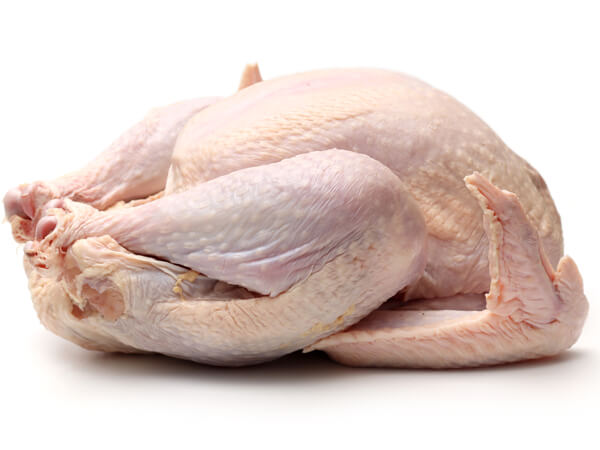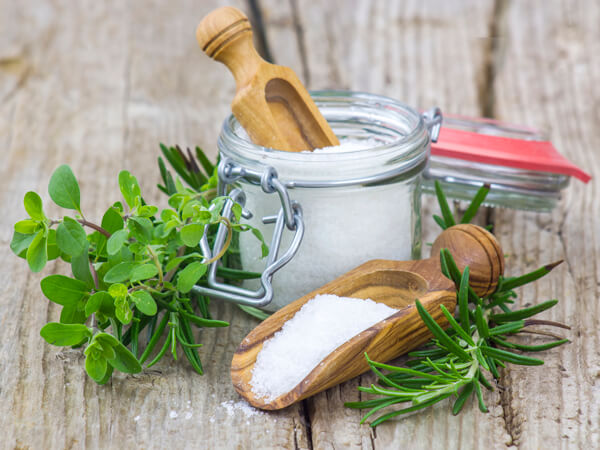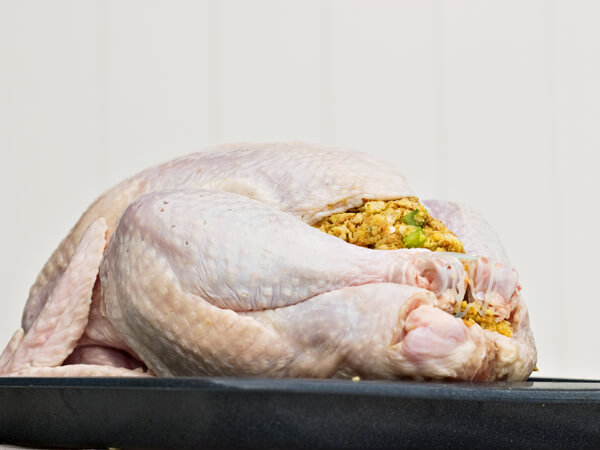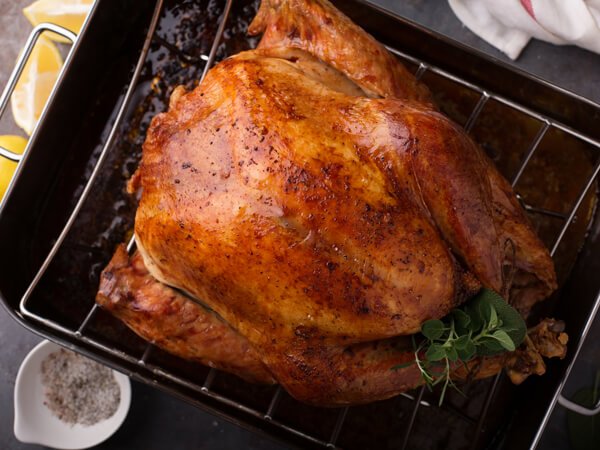Cooking the Thanksgiving Turkey

Buying The Right Turkey:
Whether you chose fresh or frozen is up to you, just remember to account for thawing time with a frozen turkey. Fresh turkeys should not be purchased more than 1-2 days before cooking. Many grocery stores and meat markets require that you order your fresh turkey (especially in the case of organic and free-range turkeys) in advance.

How Big A Turkey To Buy?
Use these guidelines to determine the size turkey you need. If you want leftovers for sandwiches, soups, etc, make sure to buy a little more than needed.
1 to 1 1/2 pounds of turkey per guest when buying a whole, ready-to-stuff bird (fresh or frozen)
1 3/4 to 2 pounds of turkey per guest when buying a pre-stuffed turkey (frozen, uncooked)
3/4 pounds of turkey per guest when buying a breast of turkey (bone in, fresh or frozen, uncooked)
1/2 pound of turkey per guest when buying boneless turkey, breast or thigh and leg, fresh or frozen.
Thawing The Turkey:
Never, EVER, thaw a turkey on the countertop. This causes bacteria and toxins to form that may not be killed when cooking. Thawing poultry at room temperature is very unsafe. Poultry should be thawed below 40F. The "danger zone" for growing bacteria is from 40-145F.
The best way to thaw a turkey is in the refrigerator. Allow 24 hours for every five pounds of turkey, and after thawing, keep a turkey refrigerated for only a day or two before cooking.
If you don't have room in your refrigerator to thaw the turkey, you can use a water bath. Submerge the frozen bird in cold water (do not ever use warm water) and change the water every 30 minutes. Allow about 30 minutes of defrosting time per pound of turkey. Cook bird immediately when thawed. If your sink isn't big enough to hold the bird for a water bath you can use a bathtub, cooler, or even a garbage can. Just make sure the bird is fully submerged.
Never refreeze thawed meat before cooking.

Brining The Turkey (optional):
A popular way to create a deliciously moist turkey is by brining the bird prior to cooking. Brining is easy, it just takes some planning.
Basics of Brining:You need to keep the turkey chilled while doing this, so either you'll need to have a stockpot or bucket that will fit into your refrigerator (with the turkey inside it), or a cooler or garbage can large enough to fit the bird.
What you need: 2 cup kosher salt per gallon of water. If you use table salt you'll only need 1 cup per gallon of water.
Rinse the turkey inside and out (remove giblets). If you are using a cooler or garbage can to brine, place about 2 inches of ice in the bottom of it. Place the turkey in a clean, food-safe plastic bag and place into the cooler. Add water and salt to completely cover the bird, tie bag shut securely. Fill cooler with more ice so the bird is kept chilled on all sides. If you are brining in your refrigerator, place the bird in the stockpot or bucket and cover with the water and salt.
Brine for 4 hours. Remove turkey from brine and rinse *thoroughly* under cold water. If not cooking immediately, return to refrigerator. Otherwise, proceed with stuffing and roasting the turkey.
If you want to brine overnight, cut the amount of salt in half. Just make sure the bird stays chilled at all times.
Some brines use sugar and other flavorings like garlic, herbs and spices. The flavors added should be imparted (slightly) on the turkey so remember that if you are experimenting with flavor add-ins.

To Stuff, Or Not To Stuff:
Stuffing a turkey can be done safely if the dry and wet ingredients are mixed just before stuffing the turkey and then the turkey is cooked immediately. Do not stuff the turkey the night before--even a few hours in advance can be unsafe.
Be sure to pack the stuffing lightly -- dense stuffing makes it difficult for the heat to penetrate. You can also bake the stuffing in a baking dish instead of in the turkey.
Check out these great Stuffing Recipes
The traditional method of cooking a turkey is oven roasting. The cooked bird should have a temperature of 180F when a meat thermometer is inserted into the meatiest part of the thigh. Do not rely on the little pop-up indicators, always use a meat thermometer for safety.
Other methods of cooking a turkey include deep frying and grilling. You'll need to consult your deep fryer or grill manufacturer's instructions for methods specific to your appliance.

Approximate Cooking Times at 325 degrees F:
| Unstuffed | |
| Size of Turkey | Cooking Time |
| 8 to 12 pounds | 2 ¾ to 3 hours |
| 12 to 14 pounds | 3 to 3 ¾ hours |
| 14 to 18 pounds | 3 ¾ to 4 ¼ hours |
| 18 to 20 pounds | 4 ¼ to 4 ½ hours |
| 20 to 24 pounds | 4 ½ to 5 hours |
| Stuffed | |
| Size of Turkey | Cooking Time |
| 8 to 12 pounds | 3 to 3 ½ hours |
| 12 to 14 pounds | 3 ½ to 4 hours |
| 14 to 18 pounds | 4 to 4 ¼ hours |
| 18 to 20 pounds | 4 ¼ to 4 ¾ hours |
| 20 to 24 pounds | 4 ¾ to 5 ¼ hours |
